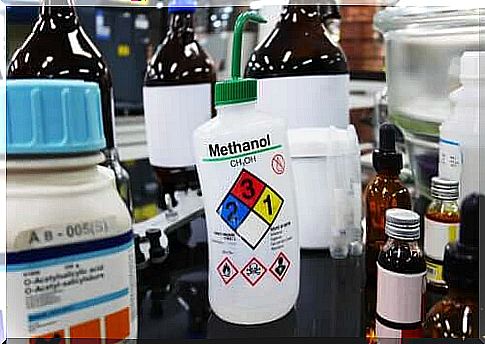Everything You Need To Know About Methanol Poisoning

Methanol poisoning is a very real problem.
Methanol is a type of alcohol that is colorless and volatile at room temperature. It is also known as wood alcohol or burning alcohol. It is often used in industry, laboratories and in the home, since it is found in many cleaning products, antifreeze, paints and varnishes.
Intoxication can occur by accident by handling these products by inhalation. In many countries, however, the most common form of intoxication is voluntary when it comes to suicide.
In addition, there is fraudulent use of this substance as a substitute for ethanol in secret produced alcoholic beverages. They cause several people to get drunk at the same time, which results in an outbreak in the emergency room.
Methanol poisoning is very rare. However, it has a high mortality rate, between 26 and 50%. On the other hand, in cases where it does not cause death, it leaves a large number of neurological and visual consequences, including blindness.
Therefore, in this article we will tell you everything you need to know about methanol poisoning, its symptoms and what to do if you, a friend or relative are poisoned by this drug.
What is methanol and where is it found?
As we have said, methanol is a colorless, volatile, flammable and non-drinkable type of alcohol. It is toxic to our body, unlike ethanol, which is in alcoholic beverages. We can get it from the distillation of wood, although it can be synthesized from carbon monoxide or methane.
It can be found in:
- Antifreeze, washer fluid and natural gas pipes.
- Solvents used in industry to produce inks, resins, adhesives and dyes.
- As a solvent for the production of cholesterol medicines, antibiotics, vitamins and hormones.
- Fuel for energy production.
- Methanol is found naturally in many foods such as fruits and vegetables. Methanol helps regulate human genetic activity and facilitates food metabolism. However, the doses in these foods are very small and not toxic at all.
- Methanol is used to denature ethanol. It prevents people from drinking products that contain ethanol, such as mouthwash and fuel mixtures.
- Methanol can be produced during the production of alcoholic beverages or distillation. In approved alcoholic beverages, methanol is below toxic doses, but this is not the case with those made in secret.
- Aspartame is an artificial sweetener that, when digested in the body, is converted into phenylalanine, aspartic acid and methanol. However, the amounts produced by the digestion of aspartame are lower than the exposure caused by fruits and vegetables.
The dose at which methanol begins to be toxic is 100 mg / kg, which is equivalent to approximately 30 milliliters of pure methanol. The toxic level in the blood is from 0.2 g / L and above. Some foods have methanol. However, they are far from reaching the toxic dose.

Why is methanol so dangerous?
When we ingest methanol, the intestine absorbs it and it reaches the blood. In itself, methanol is not toxic, although it can depress the nervous system and make us dizzy or drowsy. However, the liver breaks down methanol to formic acid, which is a very toxic substance.
What does formic acid do in our body?
Our blood has a level of acidity or pH that must be kept stable so that the cells in our body can function well. The extent of this acidity must be around 7.35-7.45. If it is less than 7.35, it means that the pH is low, ie that the blood is more acidic than normal.
So if we have formic acid in our blood, the pH drops and causes the cells to stop functioning properly and die. This process is called metabolic acidosis and, if left untreated, can be fatal.
What are the symptoms?
The symptoms of methanol poisoning range from 40 minutes to 72 hours, although symptoms usually appear within the first 12 to 24 hours. However, the person may become intoxicated by the methanol before this time.

Symptoms and signs of intoxication usually affect:
- Central nervous system: In mild or moderate intoxication there is a headache, dizziness, lethargy, lack of coordination of movement, or simply a state of intoxication similar to alcohol intoxication. In severe cases, however, seizures, coma and cerebral edema may occur.
- Eyes: There are changes in vision that look like blurred vision, photophobia and dilation of the pupils. Loss of vision and irreversible blindness due to optic nerve atrophy can also develop as a result of direct damage from getting formic acid on the eyes.
- Gastrointestinal system : Due to its irritating effect, nausea, vomiting and abdominal pain occur. However, if left untreated, intoxication can affect the pancreas, causing it to become inflamed and damaging the liver.
- Other manifestations : To compensate for the acidity of the blood, the body tries to eliminate acid by getting rid of CO2, which gives acid reflux. In other words, you start breathing very fast and shortness of breath occurs.
What should I do if I have methanol poisoning?
If you think you have ingested or inhaled methanol, you should go to the emergency room immediately. The same is true if a family member or friend has taken methanol to harm themselves.
At the hospital, if no more than two or three hours have passed since ingestion, doctors can perform a stomach pump to prevent the methanol from being absorbed and to avoid methanol poisoning.
However, we may not realize that we have methanol poisoning since methanol does not cause symptoms until after one or two days. Although in these situations you must go to the emergency room immediately, you do not need stomach pumping, but other treatments:
- General measures : Stabilize the affected person by giving bicarbonate to increase pH and reduce acidity, hydration and respiratory support, folic acid (to avoid ocular sequelae) and vitamins.
- Avoid conversion of methanol to formic acid in the liver : Ethanol uses the same enzyme as methanol to metabolize in the liver and has a much higher affinity. Therefore, to prevent methanol from using this enzyme and producing formic acid, doctors inject ethanol. Doctors can also use a drug called Fomepizole to inhibit this enzyme, but it is very difficult to obtain and very expensive.
- Hemodialysis : This cleanses the patient’s blood of methanol and formic acid.
The doctor must perform these treatments quickly to avoid comorbidities, especially blindness, and the death of the intoxicated person.









